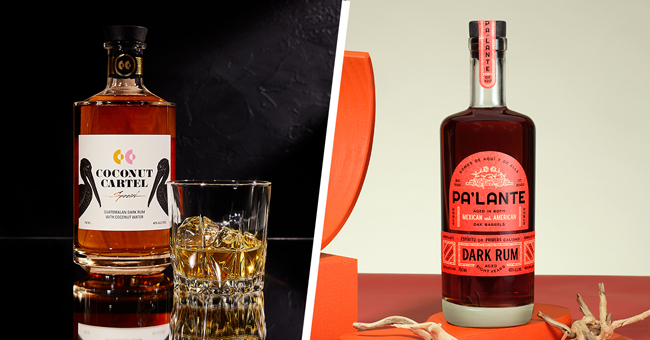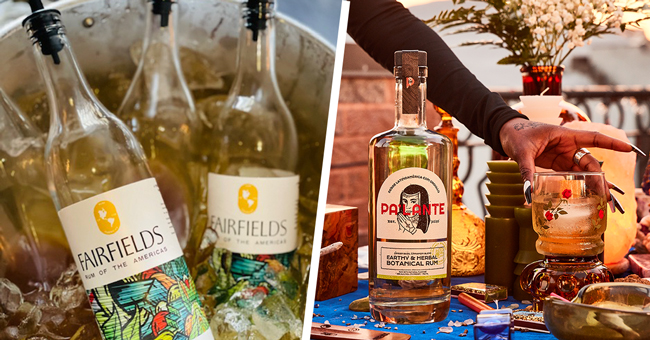
As demand for premium-plus tequila and whiskey continues to grow, will high-end and craft rums help boost the category? A new crop of brands and entrepreneurs offering rums that are premium flavored, sustainable, and positioned for craft cocktails are betting on it.
They might not be the only ones hoping to get in on rum’s potential. Last week the Brown Forman Corporation announced it had reached an agreement to purchase the Diplomático Rum family of brands, which hold top placements for super and ultra premium rums. Diplomático, which hails from Venezuela, falls in a category of rum that has experienced some growth in recent years.
While rum sales by volume fell 1.4% from 2020 to 2021 according to the Distilled Spirits Council of the United States (DISCUS), premium-plus rums have been a bright spot for the category. The compound annual growth rate (CAGR) for global premium-and-above rum volumes was +8% between 2014 and 2019, with value up +9% over the same period, according to drinks data company the IWSR. The same report predicts that premium-plus rum volumes are expected to climb 6% between 2021 and 2026. Still, compared to its aged competitors, rum is catching up on the premiumization trend.
The category is not without obstacles: the lack of classifications and the diversity of global rums can make it confusing for consumers who may be more accustomed to scotch and tequila. Recently, calls for the industry to confront its ties to colonialism and slavery have gotten louder. And rum hasn’t entirely shed its reputation as a mixable clear spirit, either.
Danielle “Zig” Zighelboim, the co-founder and CEO of Coconut Cartel, a specialty rum cut with fresh coconut water, said tax incentives from the U.S. government fueled the growth of low-cost rums produced in Puerto Rico and U.S. Virgin Islands. That rum excise tax cover-over, which has provided an easier ride for some of the major rum players, and may have contributed to enshrining brands like Bacardi and Captain Morgan in American drinking culture.
“When the whole country is being told this is rum and this is the price point and this is how you drink it, that’s what people think rum is,” she said.
But new brand owners like Zighelboim say they’re up for the challenge to expand the perception of the category. The shifting thirst for craft spirits and cocktails, plus a tiki resurgence, could help.
“Over the last couple of months, there’s been a definite uptick of people who have come in and asked for specific brands of pot distillate rums,” said Amanda Sasser, a longtime hospitality consultant and Beverage Director at The CanTiki in Los Angeles, where she curates a selection of at least 40 rums and rhums. (Rhum or rhum agricole refers to a distillate from pressed sugar cane, versus fermented juice or molasses). “I think that these kinds of funky, unique rums are the way of the future and just going to continue to gain popularity.”
The increased availability of imported rums and sugar cane-distilled rhums, along with the adoption of new aging technology by distilleries like Lost Spirits, have made this an exciting time for consumers to explore the category’s range, said Sasser.
Part of rum’s distinction from other preiuminized aged spirits is the lack of standard classifications for the category. Unlike tequila, which has specific restrictions around aging and additives, and a domination of origin within Mexico, rums can be made anywhere with molasses or fresh sugar cane, aged in different ways and sourced and blended from various distilleries. The terms “white and dark rums” are increasingly insufficient at capturing the spirit’s diversity. But those lack of rules also provide distillers and brands more freedom.
“The thing that’s exciting and not exciting is there aren’t as many rules in making rum,” said Sasser. “So it’ll be interesting to see where the laws go when distillers in the U.S. start to experiment more with pressed sugar cane in our rums, which is not traditional here.”
While America’s rum manufacturing industry died down after prohibition, newer distillers have been producing regional rums. Brands like Privateer Rum revived a New England tradition and Oahu’s KōHana Distillery produces single sugarcane variety agricole rums. Regardless of distilling location, many of the members of this latest crop of rum brands are leading with messaging that promotes no-additives, carefully sourced ingredients or transparent practices that will appeal to consumers in search of better-for-you and more sustainable drinks.

Frank Klein, co-founder of Farfields Rum of the Americas, wanted to launch his brand with a silver rum that showcases sugarcane just as a premium tequila would showcase the flavors of agave.
“Our goal was to parallel tequila and the beautiful nature of a natural spirit,” he said.
The impending launch will boast a silver rum sourced from sustainably grown sugar cane products from around the Americas and blended in the U.S. Klein, who has roots in hospitality, partnered with a former colleague and human resources executive Joy Branford, whose father used to sell rum door-to-door in her home country of St. Lucia. Advisors include Erik Oberholtzer, co-founder of Tender Greens.
Eventually the duo plans to introduce a single-origin distillate, and has a non-alcoholic rum in the works. The brand is also launching a RTD soon, with seasonal releases in the same spirit of craft beers or farm-to-table menus. While tequila-based cocktails and vodka dominate spirits-based RTDs, rum-based Mai Tai RTDs were some of the fastest-growing on Drizly in 2021.
“It’s too hard to reinvent the category,” he said. “But what you can do is put out the best product possible and show people how to make a simple cocktail with it.”
Other entrepreneurs are leaning on the spirit’s Latin American traditions and their own cultural roots to appeal to the Latin American demographic in the U.S.
“I think there will be more brands that speak to different types of consumers,” said Eric Zurita, CEO of Ron Pa’lante, which first launched through e-commerce sales during the pandemic. The Ron Pa’lante brand is marketed towards Latin American immigrants and children of immigrants, who, like Zurita and co-founder Eimi Ramirez, want to see their cultural traditions reflected in a premium product. The Cuban-born Zurita was partially inspired by his father, a chemical engineer who made rum for Havana Club in the 1980s.
“Right now we’re really the only brand in the space that is speaking to the Latino community in the U.S., and I think there will be others in the future,” he said.
After working in spirits and beer, Zurita launched his own rum made in Mexico but distilled in a Cuban tradition. The brand offers a botanical, a white and a dark rum, and a few flavored rums. Zurita is hopeful that as more celebrities dip their toes into the rum category— as Bruno Mars has done with SelvaRey, most prominently — consumers will follow, eventually driving more opportunities for investment, which has been elusive for Zurita beyond friends and family.
“I think there’s more venture capital money in canned cocktails and RTDs, and then probably agave after that, but for us being in the rum space people don’t always believe we can make something happen in this category,” he said.
Zurita and Ramirez suspect that craft cocktails featuring the brand’s flavored offerings will attract younger drinkers. The brand’s botanical, which is positioned to replace a gin or a rum in cocktails, blends basil, cinnamon and ginger, and is the highest seller. Botanical and flavored spirits have been on the uptick, with large and start-up brands experimenting with new flavor combinations. In 2020, flavored subcategories significantly outperformed traditional non-flavored sub-categories, and the demand will likely spillover from RTDs to spirits, according to a IWSR report. In 2020, flavored American whiskey volumes increased 79%, flavored gin grew 12% and flavored tequila volumes went up by 26%.
“A lot of really good cocktail spots have been playing around with our flavored rums, which is something that we’re revitalizing in the category because flavored rums are traditionally not something that’s thought of as a premium spirit for craft cocktails,” said Zurita.
Zighelboim also sees the coconut water blended into her Guatemalan aged rum as a lure to familiarize consumers with sipping rums. The brand launched 2018, after Zighelboim and her brother shifted their businesses from fresh coconuts to a boozy version, inspired by her family’s home tradition to combine aged rum and coconut water. They sell online to 40 states, are distributed in 13, and sell in three international markets. But you won’t catch the co-founder referring to Coconut Cartel as a coconut rum.
“We position it within the premium rum category and see it as an entry level rum for people who are new to sipping rums or a spirit avid rum drinkers can play with,” she said.
Zighelboim says she’s encouraged by rum’s success in other countries. Rum has become more fashionable in France and the UK, and while premium-plus consumption is heavily concentrated in the U.S., the category is also performing well in a number of other countries, including European markets, Canada and Australia.
“I think people are going to see when they travel or through social media that rum is big elsewhere in the world, it’s just not there yet in the U.S.,” she said.